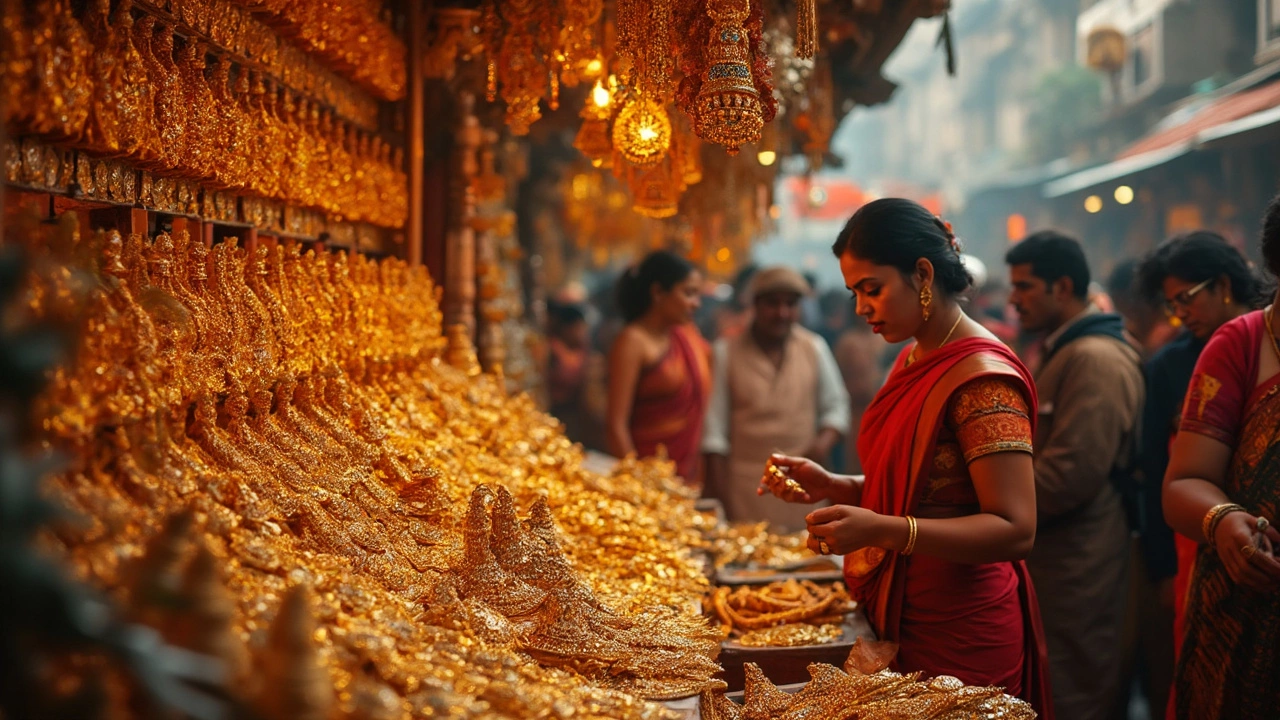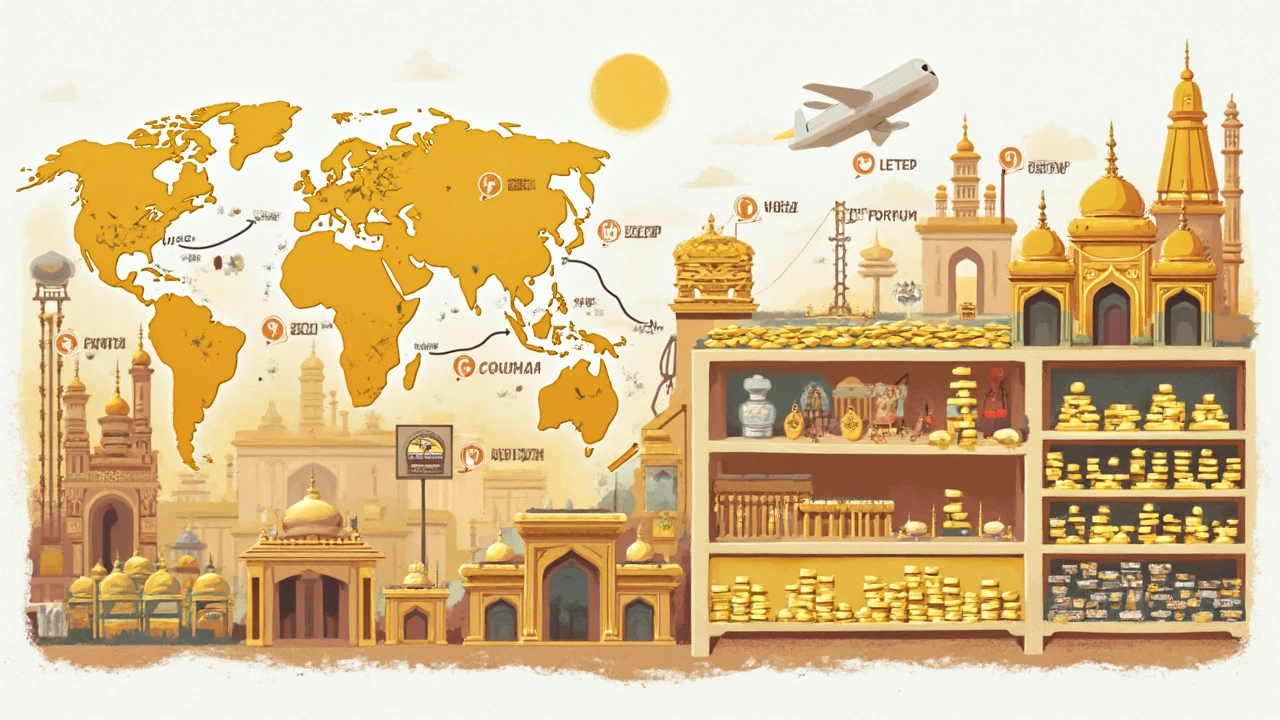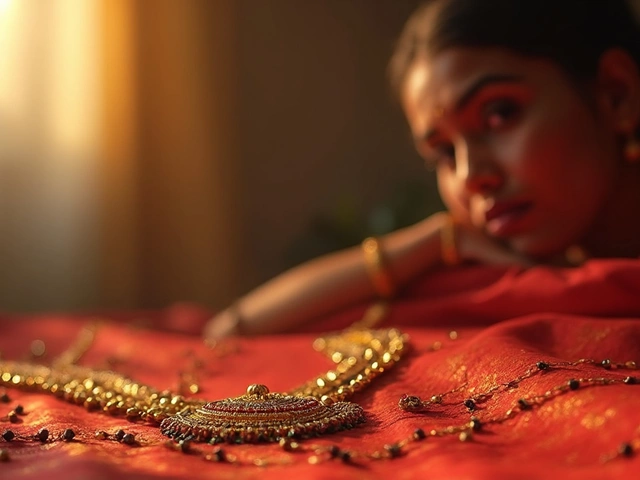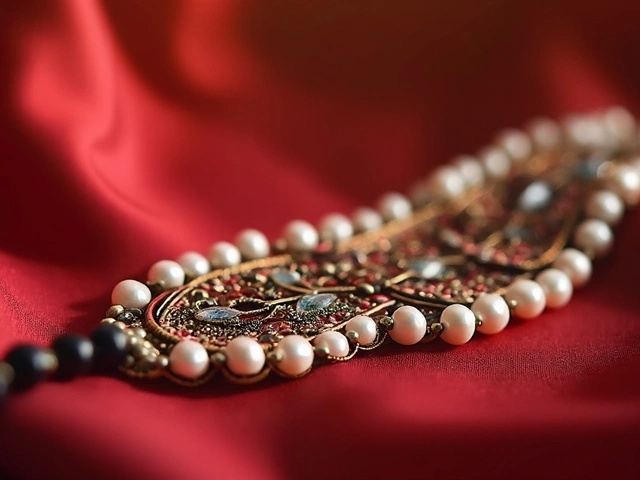
Ever noticed how gold feels way more affordable in India, especially when you’re eyeing temple jewellery? The price tags there can make your jaw drop compared to what’s listed in Western countries or the Middle East. But it’s not just luck or some secret handshake at the jeweler. It actually comes down to a mix of how India handles gold imports, taxes, and the fact that every major festival seems to be an excuse to buy a little more.
If you’re thinking about buying temple jewellery or want to understand what really drives those shiny yellow prices down, it helps to know how the market works and where you can stretch your rupee. Let’s clear up the common myths and get to the bottom of what makes India’s gold scene so different and sometimes, a bargain-hunter’s dream.
- How Gold Prices Are Set in India
- The Role of Customs and Taxes
- Cultural Habits and Gold Buying
- Tips for Buying Temple Jewellery in India
How Gold Prices Are Set in India
Gold prices in India don’t pop up out of thin air. They start with international gold rates. Most Indian jewellers and traders track the price set by the London Bullion Market Association (LBMA). This acts as the base, and then a bunch of local factors slam on top. These include the Indian rupee’s value against the US dollar, import duties, GST, and even city-to-city demand.
Local gold associations, like the Indian Bullion and Jewellers Association (IBJA), publish daily gold rates based on global market trends plus local adjustments. What’s wild is that gold prices can swing by the hour depending on market news, fluctuating currency, and even sudden political changes.
Here’s how the major ingredients break down:
- The international spot price (set in USD/oz)
- Conversion to rupees based on daily exchange rates
- Government import duty (as of 2025, it’s about 15% combined with other levies)
- GST (Goods and Services Tax) – usually 3% on gold value
- Making charges, which cover design and craftsmanship, especially for temple jewellery
So, even if international rates go up, a sudden strengthening of the rupee can make gold a little cheaper locally, and vice versa. Regional gold markets in cities like Chennai, Mumbai, or Kolkata tweak their prices a bit for logistics and demand, so don’t be surprised if prices aren’t identical everywhere.
| Cost Factor | 2025 Rate/Value |
|---|---|
| Global Gold Price (LBMA, USD/oz) | $2,300 |
| INR/USD Exchange Rate | ₹84 |
| Import Duty (total) | 15% |
| GST | 3% |
| Typical Making Charges | 5–12% of gold value |
If you want to track the best time to buy, keep an eye on the global gold rate and India’s official gold price board. Even a small dip in the rupee or a festival season can mean instant savings if you play it smart.
The Role of Customs and Taxes
Weird as it sounds, India actually slaps hefty import duties on gold—so you’d think this would make it pricier, not cheaper. As of late 2024, the basic custom duty on gold bars sits at 15%, and there’s also a 3% Goods and Services Tax tacked on top. But even with those taxes, Indian gold often comes out cheaper than what you’ll pay in Europe or the U.S. Why? Local demand, bulk buying, and the massive network of gold traders play a big role in keeping costs competitive. Indian jewellers buy huge quantities straight from authorized importers. That big buyer energy means they can negotiate better rates and split costs across tons of customers, especially during peak wedding or festival seasons.
Here’s a quick look at how some of the costs stack up:
| Country | Import Duty on Gold | Sales Tax/VAT |
|---|---|---|
| India | 15% | 3% |
| USA | 0% | 0-10% (varies by state) |
| UK | 0% | 20% VAT |
| UAE | 0% | 5% VAT |
Also, jewellers in India are known for swapping gold old-for-new with minimal paperwork, which cuts costs for customers looking to upgrade their pieces. This 'exchange culture' is something you won’t see much in other countries. It brings down the price when you’re buying pieces like temple jewellery that often use your old gold as part of the deal.
If you plan to buy gold in India, keep an eye on duty changes in the Union Budget, which rolls around every February. Even a small tweak in import duty can make the local gold price shoot up or drop overnight. Plus, buying during off-peak times, right before festivals or wedding seasons, might score you better deals since jewellers compete hard for customers.

Cultural Habits and Gold Buying
It’s no secret—gold holds a special place in India’s culture, and that’s not just a saying but a fact stamped into weddings, festivals, and even day-to-day gifting. Families buy gold for everything: Diwali, Akshaya Tritiya, weddings, and even baby showers. The country’s demand is so massive that, just last year, Indians bought about 700 tons of gold, making India the second biggest consumer after China.
What drives this? For starters, folks treat gold as a mix of jewelry and savings account. In some rural areas, nearly every household owns some gold, locking up cash in a form that’s easy to pass down to the next generation. So, gold isn’t just a fashion choice—it’s a safety net and a way to dodge inflation or emergencies.
When it comes to gold in India, especially temple jewellery, cultural habits actually help keep prices in check. High demand means constant turnover, so sellers operate on thinner margins. There are also thousands of small jewelers, which crank up competition and push prices closer to real market rates.
- Buying gold is almost a ritual at every important event, ramping up sales during festival seasons (especially October to December).
- Women own more than 60% of India’s gold—most of it as jewellery, a stat that’s unique compared to other countries where gold sits in banks as bars or coins.
- Local families prefer 22-karat gold, which is best for intricate temple jewellery and keeps resale options open.
| Event/Season | Average Sales Surge (%) |
|---|---|
| Akshaya Tritiya | 30% |
| Wedding Season | 40% |
| Diwali & Dhanteras | 50% |
Since buying is habitual, most people know which shops are trusted. Word-of-mouth and decades-old family jewellers matter more than flashy ads. Always look for the BIS hallmark before you buy. That stamp is your guarantee the gold is real and up to standard.
Bottom line: India’s buy-now, pass-down culture keeps gold relevant and affordable because sellers know customers won’t stop coming through the door.
Tips for Buying Temple Jewellery in India
Snagging genuine temple jewellery in India means paying attention to more than just the shine. You’ll want to walk into the market with open eyes, whether it’s a bustling shop in Chennai or a small-town Goldsmith. Here’s how you can make everything work in your favor and get the best bang for your buck.
- Check for Purity Marks: Temple jewellery is usually made with 22K gold, but don’t assume every seller is honest. Look for the BIS Hallmark—a small symbol stamped on the piece. This government rating is the real deal and tells you the gold’s purity. If the piece doesn’t have it, walk away.
- Bargain, But Know the Limits: Indian gold rates are often negotiable, but don’t push beyond reason. Gold rates are published daily in local newspapers or online. Most jewellers fix prices based on the current rate plus making charges.
- Understand Making Charges: Making charges can eat into your budget fast. For regular gold jewellery, making charges may be 8-10%, but for detailed temple jewellery, it can jump to 15-25% due to the labor involved. Always check this charge in advance and compare with different dealers.
- Ask About Buyback Policies: Big brands offer buyback on gold—handy if you ever want to upgrade or sell. Make sure to read the fine print; smaller shops may give you less, even if gold prices climb later.
- Buy During Festivals: Temple jewellery demand skyrockets during Akshaya Tritiya and Diwali, as people believe buying gold at these times brings luck. Shops roll out discounts, lower making charges, or toss in small freebies. These festivals are prime time if you want better deals.
| Type | Estimated Making Charges | Buyback Availability |
|---|---|---|
| Regular Jewellery | 8-12% | Common (Major Brands) |
| Temple Jewellery | 15-25% | Varies; Ask Before Buying |
Avoid buying just by weight unless all the details add up. Some sellers try to pass off imitation or gold-plated brass as the real thing, especially to new buyers. Always buy from shops with a solid reputation, like leading showrooms or government-certified dealers.
Honestly, the best feeling is wearing something beautiful and knowing it’s worth what you paid. So do your homework, trust your gut, and don’t let anyone rush you.


